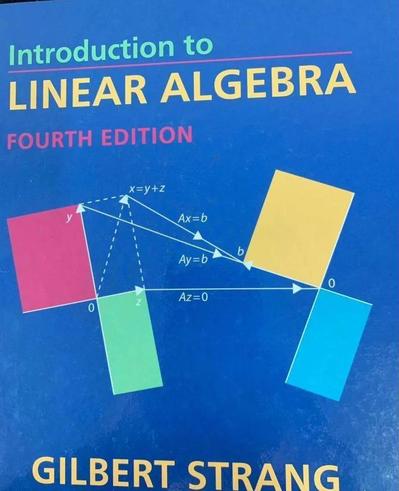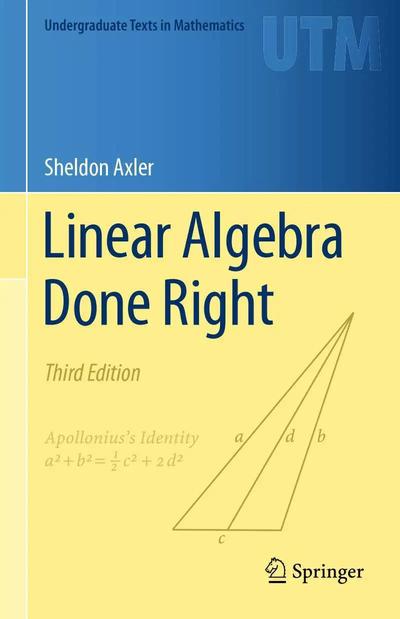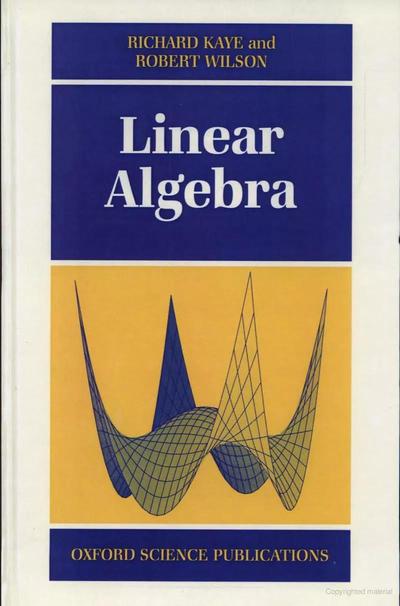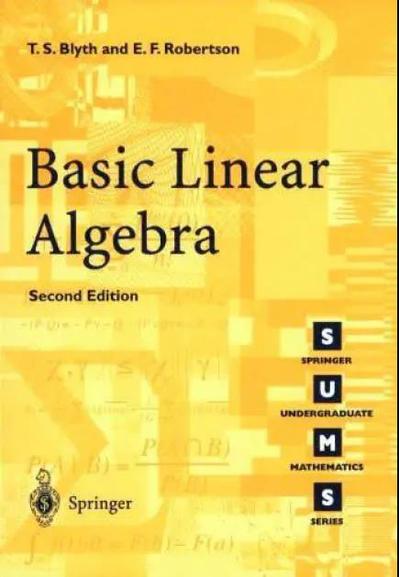目录
5 60 本教材点评
5.2 线性代数 4 本

《Introduction to linear algebra》
作者:Gilbert Strang
出版商:Hardcover
出版年:2016
ISBN:9780980232714
适用范围:本科生
推荐强度:8
作者简介:Gilbert Strang(生于1934年11月27日),美国数学家,对有限元理论,变分微积分,小波分析和线性代数做出重要贡献,他出版了七本数学教科书和一部专论。Strang是麻省理工学院MathWorks的数学教授,负责教授线性代数和计算科学与工程概论。1976年获Chauvenet奖,美国数学协会;1999年成为牛津大学巴利奥尔学院名誉院士;2005年获莱斯特·R·福特奖、冯·诺依曼奖章;2007年获苏布钦奖、亨里奇奖;2020年获欧文·塞泽尔奖。
书评:
This is an erudite and discursive introduction to linear algebra, weighted heavily toward matrices and systems of linear equations. The author has an expansive view of linear algebra, and from time to time draws in some calculus, Fourier series, wavelets, and function spaces, but the approach is always very concrete. The book doesn't skimp on the techniques of linear algebra, and there are seemingly endless examples of LU-decomposition and other numeric work, as well as a fairly extensive Chapter 9 on numerical methods. But the book also does a good job of moving up and down between various levels of abstraction, according to which level makes the problem at hand easier to comprehend, and geometrical examples and rotations play an important role in the exposition.
This book is the text for Massachusetts Institute of Technology’s Linear Algebra course 18.06, whose goals are “using matrices and also understanding them.” There’s enough material in the book for a year-long course, and the MIT course covers primarily the first seven chapters. There is a great deal of free supplemental material available on the MIT web site for the course, including videos of Strang’s lectures in the course, interactive computer demonstrations, and past exams and problem sets. The present book is complete in itself, but many students will appreciate the additional resources.
Each section of the book is structured as several pages of narrative, usually including motivational examples, followed by a several-point summary, followed by more worked examples and a problem set that focuses on drill but also includes open-ended questions suggested by the examples, and closing with a collection of “challenge problems” that really are challenging. Proofs of nearly all results are included, although the book does not use a “theorem–proof” format and doesn’t make a big deal of proving things. One potential drawback of the book’s discursive nature is that it may be hard to use for reference and review: a topic may be revisited several times to look at different aspects, so the material on a particular topic may not be wrapped up in a tidy package.
Chapter 6, on eigenvalues and eigenvectors, is especially strong and is the centerpiece of the book. It not only teaches you to think about what eigenvectors really mean geometrically and in applications, but pulls together the earlier material on spaces and linear transformations, showing why it is important sometimes to think at a higher level of abstraction.
Very Good Feature: The author frequently points out which of the concepts are the most important ones, so you don’t have to wonder whether (for example) unitary matrices are something you really care about. Some sample quotes: “The Singular Value Decomposition is a highlight of linear algebra.” (p. 363) “It is no exaggeration to say that these [symmetric matrices] are the most important matrices the world will ever see.” (p. 330)
Compared to Strang’s other linear algebra book, Linear Algebra and Its Applications, both books cover roughly the same material, but the present book is aimed lower, with more drill exercises and more handholding in the form of more-detailed explanations and more worked examples. The Applications book has more applications, as you would expect, and they are integrated into the narrative where they naturally arise rather than being collected in a separate chapter as in the present book.
Bottom line: an intriguing and challenging text that does a good job of pulling together the disparate pieces of linear algebra, but that may overemphasize matrices at the expense of spaces and linear transformations.
本书是对线性代数一次高屋建瓴而又游刃有余的介绍,其中线性方程组和矩阵内容的权重很高。作者对线性代数有广阔的视野,并时不时地穿插一些关于微积分、傅立叶级数、小波函数空间十分具体的内容。这本书没有十分刻板地只摘录线性代数的例子,也包含一些其他数值运算以及数值方法的例子,这点集中体现于第9章。这本书在不同抽象层次之间的联动方面也做得很好,既可以更轻松地理解手头的问题,也可以在更早层次自我拓展,比如旋转几何。
本书是麻省理工学院18.06线性代数课程的指定教科书,其目标是“学会使用矩阵并理解它们”。本书中有足够的材料用于一年的课程,而MIT的课程则主要专注前七章。麻省理工学院的官方网站上也有大量免费的补充材料可供该课程使用,包括Strang在该课程中的演讲视频,交互式计算机演示以及过去的考试题和习题集。这本书本身是完整的,但是许多学生会喜欢这些额外的资源。
本书的每一部分都由几页的叙述构成,通常包括示例、多点总结,之后是更多工作示例以及着重于练习的问题集,还包括示例提出的开放性问题,最后则是提出了一系列真正具有挑战性的“挑战性问题”。几乎所有定理的证明都包括在内,尽管该书没有使用严格“定理证明”格式。这本书的话语性质的一个潜在缺点是可能难以参考和审阅,因为同一个主题可能会被重新从不同角度证明,以学习不同方面的内容,因此在书中关于特定主题的学习材料是较为分散的。
第6章是关于特征值和特征向量,我认为是写的最好的,并且是本书的核心内容。它不仅教会读者思考本征向量在几何上和应用中的真正含义,而且将有关空间和线性变换的早期资料汇总在一起,从而说明了有时在更高的抽象层次上进行思考的重要性。
与Strang的另一本线性代数书《线性代数及其应用》相比,两本书涵盖的材料大致相同,但本书的目标更低一些,它包含更详细的解释和更多的示例,适合本科低年级的学生使用。
点评人:Allen Stenger(MAA西南分部网站管理员和新闻通讯编辑,《密苏里数学科学杂志》编辑)
资料整理和翻译:方诗雨 冯远航

《Linear Algebra Done Right》
作者:Sheldon Axler
出版商:Springer
出版年:2015
ISBN:978331911070
适用范围:本科生,研究生
推荐强度:9
作者简介: Sheldon Jay Axler,生于1949年11月6日,是一名美国数学家和数学教育家,主要研究方向为泛函分析与复变函数论之间的联系。现任旧金山州立大学科学与工程学院主任,著有知名教材《线性代数应该这样学》(Linear Algebra Done Right)。1971年,他以最高殊荣获普林斯顿大学数学学士学位。1975年,他在当纳德·萨拉森(Donald Sarason)指导下获得了加州大学柏克莱分校数学博士学位,博士后工作是在麻省理工学院担任门罗导师。他在密歇根州立大学执教多年,并评上了终身教授。1991年,密歇根州立大学授予他“杰出教员奖”(Distinguished Faculty Award)。1997年,阿克斯勒前往旧金山州立大学工作,并于2002年担任该校数学系主任(Chair of the Mathematics Department)。他也是《美国数学月刊》的助理编辑和《数学通讯者》的主编。2012年,他入选美国数学学会会员。1996年,美国数学协会为表彰他写的作品《Down with Determinants!》授予他莱斯特·佛特奖金。
书评:
This third edition, appearing eighteen years after the second edition, is a further polishing of the existing approach. This book was and still is an interesting and useful text for a second course in linear algebra, concentrating on proofs after the concepts and mechanics have been covered in a first course.
One immediately-noticeable difference is that the book is formatted in what I call Modern Textbook Style, which means it is printed in full color and has lots of sidebars and incidental graphics. I have mixed feelings about Modern Textbook Style; it may be necessary to sell textbooks in the present environment, but (usually) it runs up the price of the book and may be distracting. Happily neither of these bad effects seem to have happened with the present edition, and the layout is pleasant and attractive.
In addition to the hundreds of little improvements and added exercises, the main substantive improvements are the addition of material on duality (functionals were covered in the previous edition, but not dual spaces), treatment of product and quotient spaces, and a new approach to deriving results for real spaces from those for complex spaces. The new approach is called here “complexification” and just means embedding the real space in a complex space (a product of the real space with itself, along with a definition of complex scalar multiplication). The author makes the observation several times that complex spaces are easier to deal with than real spaces, and the earlier edition concentrated on transformations on complex spaces and treated real spaces in the last chapter. The new edition does the same, but the complexification simplifies the real-case proofs a good bit because they can be done a corollaries of the complex case results.
Determinants still have the very small role they did in the earlier edition, and I still think this works well. Determinants are avoided by using alternative definitions that would be theorems in a determinant approach. For example, the characteristic polynomial of a linear transformation is defined in terms of its eigenvalues (the existence of which has already been studied, without determinants) rather than as a determinant.
Every discipline of higher mathematics evinces the profound importance of linear algebra in some way, either for the power derived from its techniques or the inspiration offered by its concepts. Axler demotes determinants (usually quite a central technique in the finite dimensional setting, though marginal in infinite dimensions) to a minor role. To so consistently do without determinants constitutes a tour de forces in the service of simplicity and clarity; these are also well served by the general precision of Axler’s prose. Students with a view towards applied mathematics, analysis, or operator theory will be well served. The most original linear algebra book to appear in years, it certainly belongs in every undergraduate library. Altogether, the text is a didactic masterpiece. I congratulate the author and the publisher for a well-produced textbook on linear algebra.
今天我们所介绍的第三版,出版于第二版之后的第十八年,是对之前版本的一次进一步重大完善。对这本教材而言,无论是现在的第三版还是之前的几个版本,仍然是线性代数进阶课程中最为有趣也最为实用的。
其中一个立即值得注意的区别是,本书采用 “现代教科书风格”的风格进行格式化,这意味着该书以全彩色打印,并具有许多侧边栏和附带的图形。不过我对这类所谓“现代教科书风格”有不同的看法,在目前的环境中,可能确实存在这一类教科书的市场,但通常这类教科书的价格会很高,并且可能使读者分心。令人高兴的是,这些不利影响似乎在本版中均未发生,并且布局令人愉悦且有吸引力。
除了数百项小的改进和增加的练习之外,主要的实质性改进是增加了对偶性对偶空间、对乘积和商空间的处理,和一种新的处理计算方法。这种新方法可以从复杂空间得出真实空间的结果,被称之为“复杂化”,仅表示将实际空间嵌入到复杂空间中(实际空间与自身的乘积以及复杂标量乘法的定义)。作者多次观察到,复杂空间比实际空间更易于处理,而在较早的版本中,则是集中讨论了对复杂空间的转换和对实际空间的处理。新版本具有相同的内容,但是这种新方法大大简化了证明步骤,因为它可以直接在复杂空间中得出推论。
行列式所占的比重依然不高,我觉得这也比较合理,因为通过使用各种定理的替代定义可以避免行列式的转换计算。例如,线性变换的特征多项式是根据其特征值来定义的,而不是作为确定因素来定义的。
数学中的方方面面都以某种方式表明了线性代数的重要性,无论是从其技术中获得的力量还是其概念所提供的灵感。总而言之,这本书是线性代数进阶领域的杰出教材,再次感谢作者和出版商的贡献!
点评人:Allen Stenger(《密苏里数学科学杂志》编辑,专注于数论和经典分析领域)
资料整理和翻译:方诗雨 冯远航

《Linear Algebra》
作者:Richard Kaye & Robert Wilson
出版商:Springer
出版年:2000
ISBN:9780198502371
适用范围:高年级本科生,研究生
推荐强度:9
作者简介:Richard Kaye,数学高级讲师,专门研究数理逻辑。他的主要兴趣是非标准算术模型及其他领域。他是《皮亚诺算术模型》(OUP 1991)和《逻辑数学》(CUP 2007)的作者。于2016年底在伦敦大学玛丽皇后学院数学科学学院担任数学教授,2016年底开始提前退休。
Robert Wilson(生于1958年)是一位于2016年从伦敦大学玛丽皇后学院退休的教授,他于1983年6月任剑桥大学耶稣学院研究员,1986年7月任剑桥格尔顿学院官方研究员兼大学讲师,1987年至2004年任伯明翰大学讲师、高级讲师、教授,2004年至2016年任伦敦玛丽皇后大学代数与组合论教授。
书评:
Kaye offers this work as a second course in linear algebra. As such, it deals with the specific subject matter of linear algebra in a way that could also be viewed as an introduction to abstract algebra or axiomatic mathematics in general. Knowledge of elementary matrix arithmetic and matrix methods—including the general solution to systems of linear equations and computation of inverses and determinants—is assumed, though these topics are briefly reviewed. Some exposure to abstract vector spaces and the notions of basis and dimension would also be helpful to one wishing to peruse this book. For those with a suitable background, this book provides a very rigorous treatment of the fundamentals of linear algebra, including inner product spaces, bilinear and quadratic forms, orthogonal bases, eigenvalues and eigenvectors, and the Jordan canonical form. Certainly appropriate for upper-division undergraduates entertaining thoughts of graduate work in mathematics.
In addition, this book includes a brief introduction of fields, which may well be new material to a student who has enough knowledge. Many examples and applications of vector spaces that a typical undergraduate will see will involve fields other than IR or C, and the field axioms provide an important illustration of the axiomatic approach.And the author do not allow themselves to dwell on the subject, though, giving for example just a few examples of finite fields rather than a complete classification. In any case the main emphasis of thi book is on spaces over IR or C, and this section is optional.
Part II goes on to discuss inner product spaces in general, and also bilinear forms and quadratic forms on real vector spaces, culminating in their full description via the diagonal form given by the Gram-Schmidt orthonormalization (for inner products) and by 'Sylvester's law of inertia' in the more general case of symmetric bilinear forms. In the case of spaces over the complex numbers, conjugate symmetric forms are also considered and the corresponding laws are derived by the same methods.
Part III contains a full discussion of linear transformations from a finite dimensional vector space V to itself, their eigenvalues, eigenvectors, and diagonalization. The algorithms performing these computations are emphasized through out. Determinants are used as an aid to computations (the characteristic polynomial) but are not required for a full understanding of the theory. The book ends with two chapters that emphasize applications of the material presented in the whole book: one on self-adjoint transformations on inner product spaces and the final chapter on Jordan normal form.
In Part III, their vector spaces are over an arbitrary field F with the only condition on F being that the minimum polynomial of the linear transformation f in question splits over F.
However, there is too much material for a single course here, and it is up to the lecturer to decide on the course content and emphasis. For example, with the material in Part I, it would certainly be possible to cover all of the topics here as 'algorithms' or 'methods' in a single course, leaving the brighter students to follow up the sections explaining why some of the more difficult ideas (such as Sylvester's law of inertia, or the Jordan normal form) really do work. But some sections like 2.6,4.4 can be omitted Chapters 13 and 14 are independent of each other, so one or both of these could be omitted.
这本书是线性代数领域的进阶版教材,它对线性代数的特定主题做了处理,以符合公理数学的数学风格。虽然这本书对线性代数的一些基础知识进行了简要回顾,但是如果具备基本矩阵算术和矩阵方法、线性方程组系统的一般解、逆和行列式的计算、对抽象向量空间以及基础和维度的概念等知识的话,对阅读本书将有所帮助。对于有合适背景的人,这本书对线性代数的基础知识进行了非常严格的处理,包括内积空间、双线性和二次形式、正交基、特征值和特征向量以及约旦规范形式等。总而言之,这本教材适合高年级本科生和想在线性代数领域做一些研究的研究生。
此外,本书还简要介绍了各个新兴领域,对于有足够知识的学生而言,这很可能是启发思维的新材料。读者将看到的向量空间的许多示例和应用,不少都提供了公理方法的重要说明。尽管如此,作者也不希望读者专注于该主题,比如说书中仅给出有限域的一些示例,而不是完整的分类。
第二部分继续讨论一般的内积空间,以及实际向量空间上的双线性形式和二次形式,最后通过正交归一化(用于内积)和'西尔维斯特定律'给出的对角线形式对它们进行完整描述。至于对称双线性形式以及更一般的情况下,书中还考虑了共轭对称形式,并通过相同的方法推导了相应的定律。
第三部分全面讨论了从有限维向量空间V到其自身的线性变换,以及它们的特征值、特征向量和对角线化。书中自始至终强调执行这些计算的算法,行列式可以用作计算的辅助(特征多项式),但是不足以全面理解该理论。因此,本书以两章结尾,着重强调了整本书中所介绍材料的应用:一章是关于内部乘积空间的自伴随变换,而最后一章则是关于约旦范式的矩阵。
这本书的材料太多,在实际教学中,则需要由讲师决定课程的内容和重点。例如,使用第一部分中的材料,当然可以在单个课程中涵盖此处的所有主题,例如“算法”或“方法”,让聪明的学生跟进这些部分的内容,以解释为什么更多困难的方法(例如西尔维斯特惯性定律或约旦范式)是有效的。类似的还有书中的第13章和第14章,他们彼此独立,因此可以在教学中酌情省略这两章。
资料整理和翻译:方诗雨 冯远航

《Basic linear algebra》
作者:T. S. Blyth; Edmund F. Robertson
出版商:Springer
出版年:2000
ISBN:9781852336622
适用范围:本科生
推荐强度:8
作者简介:T. S. Blyth,圣安德鲁斯大学应用数学系名誉教授,主要从事涉及阶数概念的代数结构研究。主要兴趣分为三个领域:剩余映射、代数和有序半群以及Ockham代数。其他研究出版物包括主要数学期刊上的120余篇论文。于1974年成为爱丁堡皇家学会会员,2000年成为数学及其应用研究所研究员,里奇皇家社会科学学会会员。
书评:
Blyth and Robertson's Basic Linear Algebra sets as its goal to provide in a reasonably concise and readable form a rigorous first course that covers all of the material on linear algebra to which every student of mathematics should be exposed at an early stage. This book covers the foundational topics of matrices, systems of linear equations, vector spaces, linear mappings, determinants, eigenvalues and eigenvectors, and the minimal polynomial. It also includes a brief introduction to the Linear Algebra package of MAPLE 7. More advanced topics, such as Fourier expansion, canonical forms, and the structure of normal matrices over the real and complex field, are reserved for the sequel, Further Linear Algebra, by the same authors. Readers of Basic Linear Algebra are expected to be familiar with calculus and to have a solid experience reading and writing proofs.
The authors perform what they set out to do with this book. Basic Linear Algebra is elegantly concise. It is written in a clean example-theorem-proof style, where the story is told by judicious choice and ordering of the examples and concepts, from the concrete and familiar to the general and abstract. For instance, Chapter 6 dedicated to linear maps, starts off with some concrete examples that are used to develop the notions of Image and Kernel spaces and to prove the Dimension Theorem. These concepts then are used to show that any two finite dimensional vector spaces of the same dimension are isomorphic and even to exhibit an example of a linear map on an infinite dimensional vector space (one built from real sequences that are zero in all but finitely many spaces) that is surjective but not injective.
The exercises in the book form a rich resource for linear algebra instruction for undergraduate students. There are exercises that are interspersed throughout the text and serve to ensure students' understanding, and there are more exercises at the end of each chapter. In turn, the end of the chapter set consists of standard exercises, supplementary exercises and assignment exercises. All the exercises are wonderfully selected in terms of topics and mathematical exposure to important ideas from different fields of mathematics. For example, one could learn about nilpotent matrices and then get a glimpse at the exponential and logarithmic mappings for these matrices. In another exercise, the reader finds out what an exact sequence is and proves the vanishing of the alternating sums of the dimensions of the vector spaces in such a sequence.
This book is clearly geared towards students of mathematics (rather, perhaps, than to users of linear algebra from other disciplines). The manner of exposition is terse yet very clear and elegant, and it is apparent the authors are algebraists. Concepts tend to be introduced axiomatically; the authors usually begin by asserting a theorem that there exists some (perhaps unique) object satisfying certain axioms, and then constructing such an object as part of the proof. This style is very precise and rigorous, but may challenge some readers who are not yet accustomed to this mode of discourse. For instance, Theorem 1.2 on page 4 asserts that There is a unique m x n matrix M such that, for every m x n matrix A, A + M = A. Then, in the proof, they construct an m x n matrix whose entries are all 0, and then they prove that it is the unique matrix with this property. After that, they define the resulting matrix to be the m x n zero matrix. As another (quite inspiring) example, Chapter 8, which is dedicated to determinants, starts off with an axiomatic definition of a determinantal mapping as a multilinear, alternating, and 1-preserving mapping. Then the authors inductively construct a determinantal mapping on n x n matrices from a determinantal mapping on (n-1) x (n-1) matrices (disposing of the 2 x 2 case separately) and then establish uniqueness by setting up basic concepts from the theory of permutation groups.
In the end, I suspect that this book's somewhat abstract and spare expository style may stretch the mathematical sophistication level of many American undergraduates who are taking a first course in linear algebra, but I would relish the opportunity to offer an honors course in linear algebra from it or to suggest this book for supplementary readings and projects for motivated students. I believe Basic Linear Algebra is a valuable reference for an inspirationally elegant and streamlined algebraic development of the foundational ideas of the subject.
Blyth和Robertson合著了这本基本线性代数教材,目标是以合理简洁且易于理解的形式来完成线性代数的基础教学,因此它基本涵盖了线性代数有关的所有基础内容,适合初入门的同学们学习。本书包含矩阵、线性方程组、向量空间、线性映射、行列式、特征值和特征向量、最小多项式等基础主题,以及MAPLE 7软件包简要介绍。除此之外,也有一些较为艰深的主题,例如傅立叶展开式、规范形式、复数域上正交矩阵的结构等,和作者的后续作品《进阶线性代数》形成了很好的连贯性。
本书的定理以最简洁的方式编写,通过示例和概念的合理排序(从具体熟悉的到一般抽象的)来叙述。例如专门讨论线性映射的第6章,从一些具体示例开始,这些示例用于开发图像和内核空间的概念以及证明维数定理,然后进一步这些概念可以用于表明相同维数的任何两个有限维向量空间都是同构的,更进一步还可以展示无限维向量空间上的线性映射。
本书中的练习为本科生的线性代数教学提供了丰富的资源。每章节都有一定的练习量,最后还有专门的习题库。每章的练习分为标准练习,补充练习和作业练习,也是采用层层递进的逻辑编写。这里所有的练习都是根据主题和数学性精挑细选的,隐含着不同数学领域的重要思想。
显然,这本书的作者是一名代数学家。概念倾向于公理性的引入:作者通常首先断言一个定理,即存在满足某些公理的某些(也许是唯一的)对象,然后构造这样的对象作为证明的一部分。这种风格非常精确和严格,但是可能会给尚未习惯这种话语方式的读者带来一些挑战。例如第8章专门讨论行列式,从行列式定义和行列式映射开始,然后作者从对(n-1)*(n-1)个矩阵的行列式映射(分别处理2 * 2个情况)归纳地构造对n*n个矩阵的行列式映射,然后通过从理论上建立基本概念来展示唯一性排列组。
最后,我怀疑这本书有些抽象和多余的说明性风格可能会加大美国大学生数学教学的复杂程度,但我很乐意借此机会把这本书推荐给学有余力的学生作为补充阅读。我相信《基本线性代数》这本书对于理解优雅精简的线性代数基础思想,是一个很有价值的参考。
点评人:Maria G. Fung(西俄勒冈大学数学助理教授)
资料整理和翻译:方诗雨 冯远航
